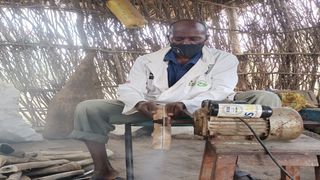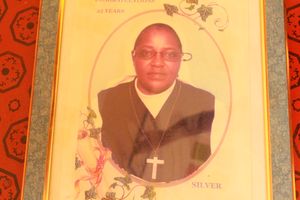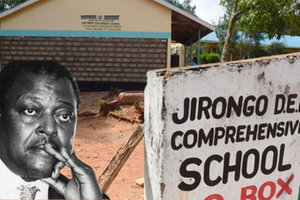
Galgalo Golo curving out livestock bones to create art at their workshop in Hamesa Village, Tana River County.
| Stephen Oduor I Nation Media Group.Tana River
Premium
Tana pastoralists find value in dried animal bones
While the rest of Hamesa village in Tana River County wakes up, and heads to farm, or to tend to cattle, 54-year-old Galgalo Golo wakes up to boil fresh bones.
For four hours, he prepares his raw material and sets up his workshop ready to grind in the creation of art that has earned him both a fortune and a name.
Inspired by people who used to come into Garsen town with a truck to collect bones from hotels and butcheries, Galgalo sought to find out the secret behind their collections.
“It was unusual for a normal human being to collect such smelling bones for a whole week, carry them comfortably on their backs to the truck and still guard it with such zeal," he says.
Galgalo abandoned his honey enterprise to pursue the secret behind the bones business, a journey that would give birth to his lucrative enterprise.
During his three-day stay in Industrial Area in Nairobi, he witnessed how the bones were converted to art that sold for a fortune in the market.
He returned home with an idea and resolved to embark on the business as he had an advantage compared to the people he visited.
“I was closer to the raw materials, so I thought we are better positioned to make a killing from this idea, given that it was untapped in this region," he says.
It took him three months to learn the art courtesy of Bemos Craft, a Nairobi-based organisation skilled in carving art from bones.
Galgalo started with making key holders, flower vases and candle stands from the bones, which he sold for Sh300 per piece.
Dry bones and horns from which buttons, necklaces, earrings among other art are made.
"Many did not believe I was carving the art from livestock bones. I was arrested twice by the KWS officers who believed I was dealing in Ivory," he recounts.
His vindication inspired many to join him, with several women expressing interest in learning the art and be part of his group.
Soon, they formed a community-based organisation that got the attention of the Kenya Drylands Livestock Development program that took them for further training and equipped them with three machines.
“In the beginning, we used to make our art manually. We used iron files, hacksaws, and sandpaper to create things. It was a tough job that saw many quit,” he says.
An idea that started with Sh5,000 has grown to employ 13 skilled people, each performing different roles.
While there is a group focused on processing art, another group has found fun in collecting the bones, even as they are required to ensure none of the bones is from wildlife.
Harassment
“We have had difficult times establishing this trade. It needs an experienced KWS officer to understand what we do. The risk of arrest from the ones who don’t understand is high,” he says.
The bones are first boiled to remove impurities and make them soft before they are conveyed to the gallery for processing to various art.
Others are cut to pieces to make necklaces, earrings, buttons, home decor, traditional cups, decor for clothes and bags while others are ground to make poultry feed.
To achieve clear art, carved art is placed in a bleaching reagent before it is decorated to various colours.
"A bleached livestock bone is similar to ivory and unless you do a lab test, you cannot tell the difference," he says.
A piece of necklace sells for Sh1,500, while chicken feed goes for Sh40 per Kilogram.
Amina Godana displays some of the art made from livestock bones at their workshop in Hamesa.
Earrings fetch Sh250, while the cups earn the group Sh800 a piece.
Though an income-generating venture, the group is yet to fully capture the coastal market, with most of the demand coming from customers in Nairobi.
“We are yet to capture the coast market. So we are working on a marketing strategy that will help us grow the business within this region,” Galgalo says.
Another challenge lies in space and resources to expand the idea.
According to the group's coordinator Amina Golo, the team has grown and has the potential to employ up to 100 youth.
“We need Sh1.6 million to move into a better building and also incorporate more machines for better productivity,” she said.
Also, the group seeks to partner with local and international designers to market the products on a bigger platform.
The bone industry, which is estimated at over Sh100 billion worldwide, is one of the most underestimated and untapped industries in Kenya.
Plans by the Tana River County administration to make the venture one of its sole income-generating industry have always ended on paper.





